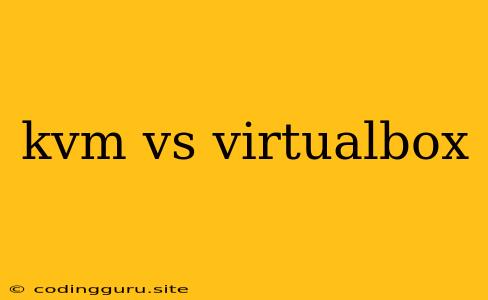KVM vs VirtualBox: Which Virtualization Solution Is Right for You?
Choosing the right virtualization solution is crucial for many tasks, from running different operating systems simultaneously to testing software in isolated environments. Two popular options often come up: KVM and VirtualBox. Both offer powerful virtualization features, but they cater to different needs and user profiles. Understanding their key differences can help you make an informed decision.
What is KVM?
KVM, short for Kernel-based Virtual Machine, is a virtualization technology built directly into the Linux kernel. It allows you to run virtual machines (VMs) directly on the host system's hardware, providing high performance and efficiency.
KVM's strengths:
- Performance: Due to its close integration with the kernel, KVM offers excellent performance, especially for demanding workloads like server applications.
- Open Source: Being part of the Linux kernel, KVM is entirely free and open source, giving you complete control and access to its source code.
- Mature and widely supported: KVM enjoys widespread adoption and support, with a robust ecosystem of tools and resources available.
What is VirtualBox?
VirtualBox is a popular virtualization software developed by Oracle. It runs as a standalone application, creating a virtual environment within your host operating system. It's a versatile option suitable for various use cases.
VirtualBox's strengths:
- Cross-platform: VirtualBox is available for Windows, macOS, Linux, and Solaris, providing a wide range of compatibility.
- Ease of use: VirtualBox offers a user-friendly graphical interface, making it easy to set up and manage VMs.
- Guest OS Support: VirtualBox supports a broad range of guest operating systems, including Windows, Linux, macOS, and even Android.
KVM vs VirtualBox: A Detailed Comparison
Let's delve into a more detailed comparison based on key factors:
1. Performance:
- KVM: Generally, KVM offers superior performance due to its direct hardware access. It excels in demanding workloads like server applications and resource-intensive tasks.
- VirtualBox: While VirtualBox delivers decent performance, it may not be as fast as KVM due to the layer of abstraction between the guest OS and the host hardware.
2. Open Source vs. Proprietary:
- KVM: KVM is an open-source project, providing complete control over the software, access to the source code, and freedom to modify and customize.
- VirtualBox: VirtualBox is a proprietary software developed by Oracle. While it's free for personal use, commercial usage might require licensing.
3. Features:
- KVM: KVM offers a wide range of virtualization features, including live migration, nested virtualization, and support for various network configurations.
- VirtualBox: VirtualBox provides an extensive feature set, including USB device passthrough, shared folders, and snapshots for restoring VMs to previous states.
4. Ease of Use:
- KVM: KVM might require a slightly steeper learning curve, especially for users new to command-line interfaces. It often requires configuring tools like libvirt and virt-manager.
- VirtualBox: VirtualBox prioritizes ease of use with a graphical user interface. It's a good choice for beginners or those seeking a streamlined experience.
5. Cost:
- KVM: KVM is entirely free to use, making it an attractive option for budget-conscious users.
- VirtualBox: VirtualBox is free for personal use. Commercial usage might involve licensing fees depending on the specific use case.
When to Choose KVM
- High-performance computing: If you need to run server applications or resource-intensive workloads, KVM's performance edge is beneficial.
- Open-source environment: KVM aligns well with a preference for open-source software, allowing complete control and customization.
- Server virtualization: KVM is a popular choice for server virtualization due to its robustness, performance, and open-source nature.
When to Choose VirtualBox
- Cross-platform compatibility: If you need to run VMs on various operating systems like Windows, macOS, and Linux, VirtualBox offers excellent cross-platform support.
- Ease of use and beginner-friendliness: For novice users, VirtualBox's intuitive graphical interface and straightforward setup process make it easier to get started with virtualization.
- Guest OS variety: VirtualBox supports a wide range of guest operating systems, making it suitable for testing different software environments.
Conclusion
The choice between KVM and VirtualBox depends on your specific needs and preferences. KVM excels in performance, open-source flexibility, and server virtualization, while VirtualBox shines with cross-platform support, ease of use, and a broad range of guest operating system compatibility. Carefully consider your requirements to determine which solution best fits your virtualization needs.
